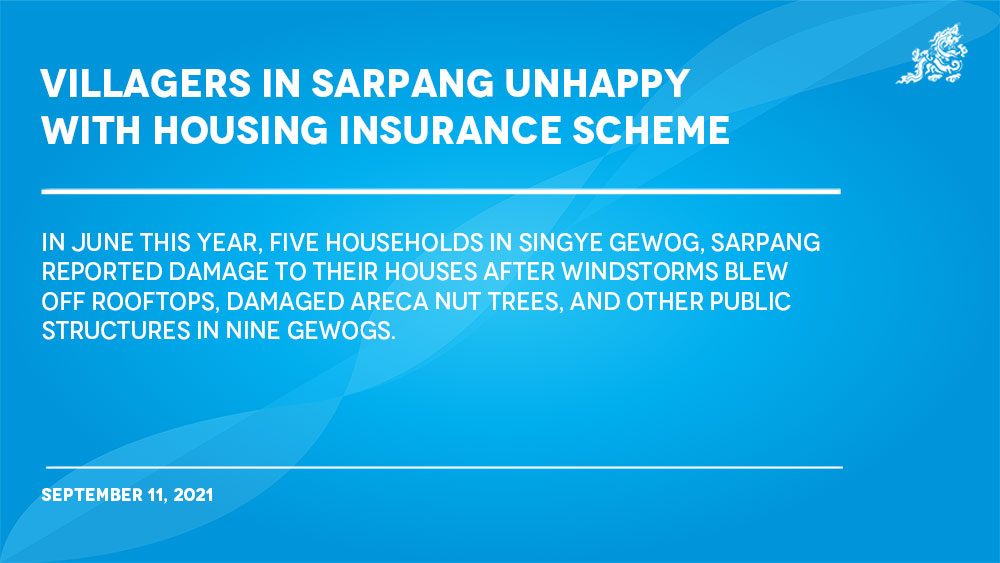Nima | Sarpang
In June this year, five households in Singye gewog, Sarpang reported damage to their houses after windstorms blew off rooftops, damaged areca nut trees, and other public structures in nine gewogs.
Gyembo Tshering from Lapsakha was the only person to receive a sum of Nu 5,000 through the Rural Housing Insurance (RHI) scheme from the gewog after the assessment.
He said that the support received through the insurance scheme helped but the amount was not enough for repair works.
“I could have done better with my repair works if I got around Nu 10,000 from the scheme. Repairing works actually could cost close to Nu 100,000,” said Gyembo Tshering.
Many residents and local government officials in the dzongkhag said that the scheme pays too little.
The issue was also discussed in the recent dzongkhag tshogdu in Sarpang in August.
Singye Gup Lachu Man Rai said that the people in the gewogs did not understand the RHI scheme properly and how the insurance scheme works.
“People expect the whole damaged parts of a structure to be compensated but the compensation is given after the assessment, which is done as per the guideline. The damage is calculated in percentage,” he said.
He added that there was no major damages reported in the gewog this year but repairing minor damages was costly for the rural folks.
“There is a need to increase the premium. It would help the rural households if the government and the bank come up with a better sum,” said Lachu Man Rai.
Suk Bdr Subba from Yarpheling, Singye gewog, said that the scheme did not help in times of disasters.
“Some houses with small damage get compensation but others don’t,” said Suk Bdr Subba.
The 68-year-old farmer claimed that a lightning last summer destroyed power line and water tank. He had to do the repairs himself.
The general manager with the General Insurance department, Royal Insurance Corporation of Bhutan (RICB), Kinga Thinley, said that the claim must be intimidated to the gewog administration or the nearest RICB office within one month from the date of loss.
“Any claims after one month will not be admitted unless a client has a genuine reason. Normal cracking of walls due to setting of cement, aging, and structural deterioration is not covered by the scheme,” he said.
The official added that RICB has standard guidelines developed in consultation with the Ministry of Finance and Ministry of Home and Cultural Affairs, which covers both underwriting and claims procedures.
“Claims could be either partial or total loss. In the case of a total loss, the maximum compensation is the sum insured. In case of partial loss, the assessment is done as per the RHI’s partial loss assessment guideline,” said Kinga.
RHI scheme is divided into four different categories depending on the type of construction and number of floors. The sum insured ranges from Nu 300,000 to Nu 60,0000.
Officials from RICB, Gelephu, said that they physically inspect the damaged houses to ensure proper assessment of the loss. The claims are transferred to the clients online to make it more convenient.
According to the record with RICB, over Nu 780,000 was collected in 2020 as a premium amount and Nu 805,000 in 2021. More than Nu 179,000 was given to eight households in 2020 and Nu 69,500 to seven households in 2021 in the dzongkhag as part of the RHI scheme.
“This scheme is a government-subsidised scheme with limited sum insured and minimum premium. The owner of the house pays a certain amount of the premium while the government pays the rest as subsidy,” he said.
The official urges the people to give correct description of houses to the gewog administration while they collect insurance premiums to avoid incorrect categorisation.
“To get better compensation we also offer commercial insurance scheme for rural houses. Another solution to this could be to revise the sum insured and compensation limit. But, the instruction for revision must come from the government based on people’s requirement and affordability to pay the premium,” said Kinga Thinley.
The scheme was revised several times to cater to the needs of rural people in line with the instruction of the government. The latest revision was done in 2012.


